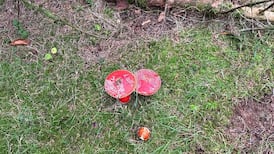To watch the big beech in the third storm was to see it summoning every sinew of its thigmomorphogenesis, an overgrown term for a plant’s ability to handle the force of the wind.
Foresters prefer “wind firmness” but that’s the outcome of a life responsive to, and shaped by, the erratic aeolian embrace. Watching the thrash and weave of the beech’s branches, the weighty shifts of twist and sway, was to hope that its huggable trunk was short enough, the roots deep and wide enough, the longer boughs buttressed enough at the weather-lean of the tree.
Everything held on the acre, even the scraggy old spruce at the gate. It came with the house and could be most of a century old.We had it lopped once but it grew back strongly to shelter the mistle thrushes’ nest.
During Storm Eunice, at about noon, Cork County Council put out a list of some 50 roadside casualties, some blocking roads or hanging from wires.
There will have been hundreds more across the island, many of them ash trees suffering dieback, or burdened with wind-catching growths of ivy, or both. The prospect is of roads webbed with modest hedgerows to a height that suits the wire-led services for power, phones and broadband.
Rarity
The National Roads Authority has already played it safe, approving low-canopy trees such as alder and birch, with tall species kept to a mere 10 per cent.
Along the railways, too, tall trees will be a rarity, as Irish Rail uses legal powers to “cut or lop” vegetation that it sees as threatening its safe operation. In 2019, it roused fierce protest by demolishing trees and hedgerows along the Dublin-Galway line in Co Offaly. This was in the “forbidden” bird-nesting month of April, but Irish Rail claimed the trees had damaged fences and were letting cattle on to the line.
Most roadside trees are the responsibility of private property owners and the Government offers a guide to preventing accidents produced by the Tree Council of Ireland. “An ‘act of God’ is not a viable defence,” it warns, “if the tree involved was obviously defective and the landowner had not checked their trees”.
Dead branches, a rising root plate, a sinister lean, deep cracks or decay “can indicate a tree whose failure in a storm is reasonably foreseeable”. A growth of ivy does no harm to a tree and has great value to insects and birds, “but it does increase the wind resistance of the tree crown during winter storms”.
Meanwhile, “windthrow” is now the greatest threat to economic forestry in Ireland, with an annual loss at some €1.3 million.
In 2014, for example, Storm Darwin uprooted trees across some 8,000 hectares (20,000 acres) of forest land. Described then as a once-in-20-years storm event, and with top wind speeds comparable to those of the February trio, it pushed Coillte’s annual average of sold windblown timber to some 240,000 cubic metres.
In 2018, Coford, the national forest research body, produced an analysis of windthrow and its management by Dr Áine Ní Dubháin and Dr Niall Farrelly. It surprised me to learn, for example, that storm gusts reach a higher force over rough wooded land than flat land, to lean harder on tall, slender trees.
The timing and intensity of thinning can be crucial to blunting a storm’s attack. But advice from Teagasc blames windthrow on the simple failure of poorly drained soil to let a tree anchor its root plate. In a project to prove the virtues of “mole” drainage, creating tunnels half a metre under the soil, its researchers engaged in “tree pulling tests and dynamic forced rocking” of Sitka spruce.
Pulling with ropes and timing tree-sway with stopwatches has given way in recent decades to data-hungry studies using sensory instruments and computers to log the wind loading of trunks and branches and “bending moments” at the base.
Experiments
One French research team put a young cherry tree in a large wind tunnel, not to bend it unduly, but to study “foliage motion under wind, from leaf flutter to branch buffeting”.
This motion was important, it felt, both for biological issues, such as the tree’s photosynthesis, extraction of energy from the wind, and the ejection of pollen, and for “more subtle effects such as on wifi transmission”.
The perception by humans of the wind-induced motion of plants, the team added, is also being explored for use in video games and animation films, where “it is essential to make realistic outdoor scenes using low computational resources”.
The team’s experiments offered its main evidence “for the first time” that foliage motion combines individual leaf flutter at low wind speeds with “branch turbulence buffeting” at higher wind velocities.
Which is rather, having watched a few wind-blown trees, what I’d have thought.










